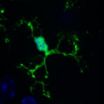(Press-News.org) Gardeners know that some trees require regular pruning: some of their branches have to be cut so that others can grow stronger. The same is true of the developing brain: cells called microglia prune the connections between neurons, shaping how the brain is wired, scientists at the European Molecular Biology Laboratory (EMBL) in Monterotondo, Italy, discovered. Published online today in Science, the findings could one day help understand neurodevelopmental disorders like autism.
"We're very excited, because our data shows microglia are critical to get the connectivity right in the brain," says Cornelius Gross, who led the work: "they 'eat up' synapses to make space for the most effective contacts between neurons to grow strong."
Microglia are related to the white blood cells that engulf pathogens and cellular debris, and scientists knew already that microglia perform that same clean-up task when the brain is injured, 'swallowing up' dead and dying neurons. Looking at the developing mouse brain under the microscope, Gross and colleagues found proteins from synapses – the connections between neurons – inside microglia, indicating that microglia are able to engulf synapses too.
To probe further, the scientists introduced a mutation that reduced the number of microglia in the developing mouse brain.
"What we saw was similar to what others have seen in at least some cases of autism in humans: many more connections between neurons," Gross says. "So we should be aware that changes in how microglia work might be a major factor in neurodevelopmental disorders that have altered brain wiring."
The microglia-limiting mutation the EMBL scientists used has only temporary effects, so eventually the number of microglia increases and the mouse brain establishes the right connections. However, this happens later in development than it normally would, and Gross and colleagues would now like to find out if that delay has long-term consequences. Does it affect the behaviour of the mice behaviour, for example? At the same time, Gross and colleagues plan to investigate what microglia do in the healthy adult brain, where their role is essentially unknown.
INFORMATION:
This work was carried out in collaboration with the groups of Davide Ragozzino at the University of Rome and Maurizio Giustetto and Patrizia Panzanelli at the University of Turin.
Gardening in the brain
Specialist cells prune connections between neurons
2011-07-22
ELSE PRESS RELEASES FROM THIS DATE:
Identical virus, host populations can prevail for centuries, WHOI researcher reports
2011-07-22
A Woods Hole Oceanographic Institution (WHOI) scientist, analyzing ancient plankton DNA signatures in sediments of the Black Sea, has found for the first time that the same genetic populations of a virus and its algal host can persist and coexist for centuries. The findings have implications for the ecological significance of viruses in shaping algae ecosystems in the ocean, and perhaps fresh water as well.
"The finding that the DNA of viruses and algal host cells can be preserved in the geological records is of great interest to microbial ecologists," said Marco Coolen ...
Plan to one day end the use of environmentally harmful chemicals on commercial crops developed
2011-07-22
(Edmonton) Two University of Alberta researchers have published a step by step plan to one-day end the use of environmentally harmful chemicals on commercial crops by developing plants that produce their own fertilizer.
U of A plant biologist Allen Good says the energy required to produce nitrogen fertilizers has pushed the world-wide cost for agricultural producers to a $100 billion a year. Good says that while they are necessary for high yields, those nitrogen fertilizers also damage the environment. Emissions from nitrogen fertilizers add to greenhouse gas emissions ...
Repairing our inner clock with a 2-inch fish
2011-07-22
Tel Aviv — Circadian rhythms — the natural cycle that dictates our biological processes over a 24-hour day — does more than tell us when to sleep or wake. Disruptions in the cycle are also associated with depression, problems with weight control, jet lag and more. Now Prof. Yoav Gothilf of Tel Aviv University's Department of Neurobiology at the George S. Wise Faculty of Life Sciences is looking to the common zebrafish to learn more about how the human circadian system functions.
Prof. Gothilf and his Ph.D. student Gad Vatine, in collaboration with Prof. Nicholas Foulkes ...
Washing away good and bad luck
2011-07-22
RIVERSIDE, Calif. (www.ucr.edu) -- Do people believe good and bad luck can be washed away?
Yes, according to an advanced online publication in the Journal of Experimental Psychology that was co-authored by Rami Zwick, a University of California, Riverside marketing professor in the School of Business Administration.
Zwick, working with Alison Jing Xu of the University of Toronto, and Norbert Schwarz of the University of Michigan, designed two experiments that showed risk taking depends on whether participants recalled a past episode of good or bad luck and whether they ...
Do we buy cosmetics because they are useful or because they make us feel good?
2011-07-22
A study by the University of the Basque Country (UPV/EHU) shows that people who use cosmetics buy these products primarily for emotional reasons. The study was carried out on facial creams (hydrating and nutritive ones, coloured or non-coloured, and anti-wrinkle creams) and body creams (firming and anti-cellulite creams).
"The study shows that both the emotional and utility aspect of cosmetic brands have a significant impact on consumer satisfaction, but that the emotional component has a greater effect", Vanessa Apaolaza, a researcher from the UPV and lead author of ...
A new discovery paves the way for using super strong nanostructured metals in cars
2011-07-22
Today, the body of an ordinary family car consists of 193 different types of steel. The steel for each part of the car has been carefully selected and optimised. It is important, for example, that all parts are as light as possible because of the fuel consumption, whereas other parts of the car have to be super strong in order to protect passengers in a collision.
Super strong nanostructured metals are now entering the scene, aimed at making cars even lighter, enabling them to stand collisions in a better way without fatal consequences for the passengers. Research into ...
University of Leicester develops test for classifying force used in bottle stabbings
2011-07-22
Engineers at the University of Leicester have for the first time created a way of measuring how much force is used during a stabbing using a broken bottle. The advance is expected to have significant implications for legal forensics.
A team from the University has conducted a systematic study of the force applied during a stabbing and come up with the first set of penetration force data for broken glass bottles. This work has been published in the International Journal of Legal Medicine (http://www.springerlink.com/content/v21t5g05250n22xw/)
Stabbing is the most ...
Study suggests obesity accelerates progression of cirrhosis
2011-07-22
Researchers from the United States and Europe involved in an NIH-funded multicenter study have determined that increased body mass index (BMI) is an independent predictor of clinical decompensation in patients with compensated cirrhosis, independent of portal pressure and liver function. The findings suggest obesity accelerates cirrhosis progression and measures to reduce BMI could improve the prognosis for patients with advanced liver disease. Study details are available in the August issue of Hepatology, a journal published by Wiley-Blackwell on behalf of the American ...
Metabolic syndrome increases risk of both major types of primary liver cancer
2011-07-22
Incidence rates of hepatocellular carcinoma (HCC) and intrahepatic cholangiocarcinoma (ICC) have increased in the U.S. This population-based study publishing in the August issue of Hepatology, a journal of the American Association for the Study of Liver Diseases, found that metabolic syndrome significantly increases risk of developing these primary liver cancers.
According to data from the National Cancer Institute, 24,120 new cases of liver and intrahepatic bile duct cancer and close to 19,000 deaths from the diseases occurred in the U.S. in 2010. Major risk factors ...
Software helps synthetic biologists customize protein production
2011-07-22
A software program developed by a Penn State synthetic biologist could provide biotechnology companies with genetic plans to help them turn bacteria into molecular factories, capable of producing everything from biofuels to medicine.
"It's similar to how an engineer designs a plane or a car," said Howard M. Salis, assistant professor in agricultural and biological engineering, and chemical engineering. "When designing a biological organism, there are many combinations that the engineer must test to find the best combination. This technology allows us to quickly identify ...
LAST 30 PRESS RELEASES:
Membrane magic: FAMU-FSU researchers repurpose fuel cells membranes for new applications
UN Member States pledge to increase access to diagnosis and inhaled medicines for the 480 million people living with COPD
Combination therapy shows potential to treat pediatric brain cancer ATRT
Study links seabird nesting to shark turf wars in Hawai‘i
Legal sports betting linked to sharp increases in violent crime, study finds
Breakthrough AI from NYUAD speeds up discovery of life-supporting microbes
New Eva Mayr-Stihl Foundation funding initiative boosts research at University of Freiburg on adaptation of forests to global change
The perfect plastic? Plant-based, fully saltwater degradable, zero microplastics
Bias in data may be blocking AI’s potential to combat antibiotic resistance
Article-level metrics would provide more recognition to most researchers than journal-level metrics
Satiety’s little helper: Protein that supports appetite regulating protein identified
UF dives deep into predicting storm damage with computer models
A stormy ocean voyage yields insights on the global carbon cycle
Scientists identify first non-coding gene that controls cell size
Demonstration of altermagnetism in RuO₂ thin films -- A new magnetic material for the AI era
Penn researchers awarded $25M to conduct trial using smartphones to fight heart disease
PCORI awards funding for new patient-centered healthcare research
Exploring the origins of the universe: 145 low-noise amplifiers complete ALMA telescopes
Empress cicada wings help illuminate molecular structure
Using sound waves to detect helium
Time burden in patients with metastatic breast and ovarian cancer from clinic and home demands
Researchers discover bias in AI models that analyze pathology samples
Scientists ID potential way to prevent brain injuries from triggering Alzheimer's
MASTER 2nd Open Call: Execution period kick-off
Algae for health in food and pharma
Advanced microrobots driven by acoustic and magnetic fields for biomedical applications
Chicago health information leader recognized for raising CPR readiness and blood pressure awareness
The Intimate Animal, a new book from Kinsey Institute Executive Director Dr. Justin Garcia
When blue-collar workers lose union protection, they try self-employment
New video dataset to advance AI for health care
[Press-News.org] Gardening in the brainSpecialist cells prune connections between neurons


